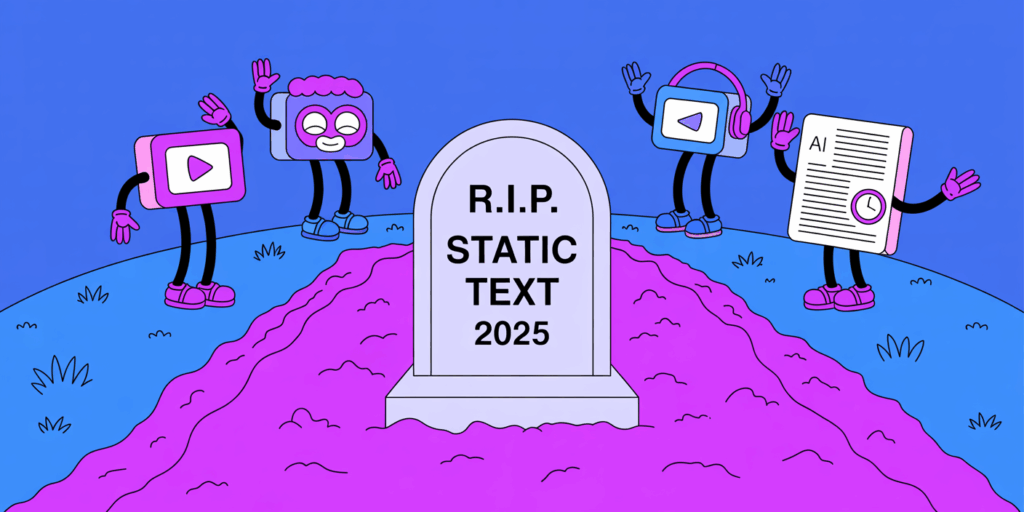The Death of Static Text

Picture this: You’re sitting in a doctor’s office, and the nurse hands you a 12-page discharge summary. Dense paragraphs, medical jargon, tiny font. Your eyes glaze over before you even finish the first paragraph. Sound familiar?
Here’s the uncomfortable truth, regulated industries are hemorrhaging their audience’s attention, and they don’t even realize it. Healthcare, finance, education… they’re all guilty of the same crime: drowning people in static text and expecting them to swim.
The average human attention span has plummeted to just 8.25 seconds. That’s shorter than a goldfish. Yet we’re still shoving 30-page policy documents at people and wondering why compliance rates are abysmal.
Something’s got to give.
The Battle for Attention is Easily Lost
Let’s be honest, when was the last time you actually read those terms and conditions? You’re not alone. A staggering 91% of consumers accept legal terms without reading them, and that number jumps to 97% for people under 34.
In healthcare, the situation is even more dire. Only 12% of American adults have proficient health literacy skills. That means nearly 9 out of 10 people struggle with understanding basic medical information, the stuff that could literally save their lives.
You know what’s crazy? We’ve known this for years, yet hospitals keep printing out those impossibly long discharge instructions. Banks keep sending mortgage documents that would make a lawyer’s head spin. Schools keep distributing policy handbooks that students use as doorstops.
It’s like watching someone try to start a fire with wet matches while a lighter sits right next to them.
The frustration is real on both sides. Patients get overwhelmed and confused. Compliance officers pull their hair out because nobody’s following the guidelines. Customer service teams field the same questions over and over because nobody read the documentation.
Why Static Text is Ignored
Here’s what’s happening in your brain when you encounter a wall of text: absolutely nothing exciting. Static text activates minimal neural pathways. It’s like trying to watch Netflix on a black-and-white TV from 1955; technically it works, but why would you torture yourself?
Think about it this way: static text is the DVD of content formats. Sure, it was revolutionary once upon a time. But when Netflix came along with its instant streaming, multiple viewing options, and personalized experience, DVDs became relics gathering dust on shelves.
The psychology is pretty straightforward. Humans are visual creatures. We process visual information 60,000 times faster than text. When you add audio and visual elements, retention rates jump from a measly 10% to about 65%.
People have gotten used to consuming information in bite-sized, engaging formats. TikTok videos, Instagram stories, podcast summaries. They expect options. They want control over how they learn and process information.
Embracing Multimedia Options (Finally)
Imagine walking into a restaurant where the only option is a bland, unseasoned chicken breast. No sides, no sauce, no alternatives. You’d probably leave, right? That’s exactly what happens when you force people to consume content in only one format.
Smart organizations are starting to get it. They’re offering content menus instead of content mandates. Want to understand your insurance policy? Here’s a 3-minute animated video. Prefer audio? There’s a podcast version. Need something visual? Check out this infographic.
The data backs this up beautifully. Video content is shared 1,200% more than text and images combined. People retain 95% of a message when they watch it versus just 10% when they read it.
But here’s what gets me excited, it’s not about replacing text entirely. It’s about giving people choices. Some folks still love reading detailed documents. Others need audio because they’re commuting. Visual learners want infographics. Busy executives prefer 2-minute video summaries.
When you provide multiple formats of the same information, something magical happens. Engagement goes up. Comprehension improves. Compliance rates increase. Customer satisfaction scores climb.
The Real-World Reality Check
The simple truth is that finding concrete case studies of regulated industries successfully making this transition is tough because most organizations are still figuring it out. The few that have started experimenting tend to keep their results close to the vest.
But think about the companies you actually enjoy interacting with. They probably don’t bombard you with dense PDFs and pages of text. They might send you a quick video walkthrough of new features. Or an interactive tutorial. Maybe a simple infographic explaining complex processes. That’s not an accident. Those companies understand that respect for their audience’s time and preferences translates directly into better relationships and outcomes.
Adapting to Your Audience’s Needs
I get that change is hard, especially in regulated industries where every word gets scrutinized by legal teams. The approval process for a simple brochure can take months. Imagining that same process for video content probably gives compliance officers nightmares.
But here’s the thing, the cost of not changing is becoming higher than the cost of adaptation. When 73% of consumers prefer watching a short video to learn about a product or service compared to just 11% who want to read about it, you’re literally fighting against human nature.
The solution isn’t to throw out all your existing content. It’s about taking that carefully crafted, legally approved text and transforming it into formats people actually want to consume. Same information, different packages.
Your legal team spent months perfecting that disclosure language? Great, now let’s turn it into a 90-second explainer video with the exact same words, just spoken with helpful visuals. Your patient education materials are clinically accurate? Perfect, let’s create an audio version for people who can’t read small print or prefer listening while they recover.
The content you’ve already created isn’t worthless. It’s just trapped in the wrong format.
So maybe it’s time to give your audience the options they actually want? Because at the end of the day, information that isn’t consumed might as well not exist at all.



